HISTORY OF SHAPES
(noun) - A shape is one of the seven elements of art. When defining it within the study of art, shape is an enclosed space, the boundaries of which are defined by other elements of art
• line
• shape
• form
• space
• texture
• value and
• color
Shapes are limited to two dimensions: length and width. Geometric shapes -- circles, rectangles, squares, triangles and so on -- have the clear edges one achieves when using tools to create them.
Organic shapes have natural, less well-defined edges (think: an amoeba, or a cloud).
The seven elements of art are those components that one combines with principles of design to construct art. The elements are as follows:
1. Geometric shapes:
Are circles, rectangles, squares, triangles and so on - have the clear edges one achieves when using tools to create them.
Most geometric shapes are made by humans, though crystals are also considered to be geometric despite the fact that they are made in nature.
2. Organic shapes:
Are shapes with a natural look and a flowing and curving appearance.
Organic shapes and forms are typically irregular or asymmetrical.
Organic shapes are associated with things from the natural world, like plants and animals.

The Meaning Of Shapes: Developing Visual Grammar
by Steven BradleyWhat do you feel when you see a circle? A square? A triangle? Are you affected the same when seeing an object with soft gentle curves as you are when seeing another object with sharp jagged edges? Much the same way that lines have meaning, shapes have meaning and are an important building block in the visual grammar and visual thinking we have at our disposal as designers.
Shapes have an endless variety of characteristics, each communicating different messages to your audience. You’d be hard pressed to design any web page without creating shapes. Even if your page is nothing more than paragraphs of text you’re laying down shapes on the page.
What kind of shapes do we have at our disposal? What do all those shapes say to our visitors? How do they enhance or detract from the concept you want to convey?
The Grammar of Shapes
I found I could say things with color and shapes that I couldn’t say any other way—things I had no words for. —Georgia O’Keeffe
Shapes are two-dimensional areas with a recognizable boundary. They can be open or closed, angular or round, big or small. Shapes can be organic or inorganic. They can be free-form or geometric and ordered.
Shapes can be defined by their color or by the combination of lines that make up their edges. Simple shapes can be combined to form complex shapes. Complex shapes can be abstracted to make simple shapes.
The different characteristics of a shape convey different moods and meanings (.doc file). Changing the characteristics of a shape alter how we perceive that shape and make us feel differently about a design. Shapes are a powerful way to communicate.
Designers use shapes to:
• Organize information through connection and separation
• Symbolize different ideas
• Create movement, texture, and depth
• Convey mood and emotion
• Emphasize and create entry points and areas of interest
• Lead the eye from one design element to the next

Types of Shapes
There are 3 basic types of shapes
• Geometric shapes are what most people think of as shapes. Circles, squares, triangles, diamonds are made up of regular patterns that are easily recognizable. This regularity suggests organization and efficiency. It suggests structure. Geometric shapes tend to be symmetrical further suggesting order.
• Natural/Organic shapes are irregular. They have more curves and are uneven. They tend to be pleasing and comforting. While they can be man-made (ink blobs), they are more typically representative of shapes found in nature such as a leaves, rocks, and clouds. On a web page organic shapes are generally created through the use of illustration and photography. They are free form and asymmetrical and convey feelings of spontaneity. Organic shapes add interest and reinforce themes.
• Abstract shapes have a recognizable form, but are not real. They are stylized or simplified versions of organic shapes. A stick figure is an abstract shape depicting a person. Typographic glyphs are abstract shapes to represent letters. Icons are abstract shapes to represent ideas and concepts. Some abstract shapes have near universal recognition. Think of some of the icons you see in the software you use daily.
Shapes can be either positive or negative. They can be figure or they can be ground. Be conscious of the shapes you form with negative space as these are just as, if not more, important than the shapes you form with positive space.
Resources for Creating Geometric Shapes with Unicode
• Unicode Geometric Shapes
• Geometric Shapes

The Meaning of Shapes
There are truly an endless variety of shapes and combination of shapes, each communicating its own meaning and message. Often the meaning behind shapes is cultural (a red octagon as a stop sign), particularly as shapes are combined. We’ll confine ourselves to a discussion of some basic geometric shapes here and I’ll provide some links to more detailed sources of shape meaning beyond the basics.
Circles have no beginning or end. They represent the eternal whole and in every culture are an archetypical form representing the sun, the earth, the moon, the universe, and other celestial objects between. Circles are used to suggest familiar objects such as wheels, balls, many kinds of fruit. They suggested well-roundedness and completeness.
Circles have free movement. They can roll. Shading and lines can enhance this sense of movement in circles. Circles are graceful and their curves are seen as feminine. They are warm, comforting and give a sense of sensuality and love. Their movement suggests energy and power. Their completeness suggests the infinite, unity, and harmony.
Circles protect, they endure, they restrict. They confine what’s within and keep things out. They offer safety and connection. Circles suggests community, integrity, and perfection.
Because they are less common in design they work well to attract attention, provide emphasis, and set things apart.
Squares and rectangles are stable. They’re familiar and trusted shapes and suggest honesty. They have right angles and represent order, mathematics, rationality, and formality. They are seen as earthbound. Rectangles are the most common geometric shape encountered. The majority of text we read is set in rectangles or squares.
Squares and rectangles suggest conformity, peacefulness, solidity, security, and equality. Their familiarity and stability, along with their commonness can seem boring. They are generally not attention getters, but can be tilted to add an unexpected twist. Think of web pages that tilts framed images to help them stand out.
Every element on a web page is defined by a rectangle according to the css box model. Web pages are rectangles made up of smaller rectangles and squares.
In Buddhist symbolism a square (earthbound) inside a circle (eternal whole) represents the relationship between the human and the divine.
Triangles can be stable when sitting on their base or unstable when not. They represent dynamic tension, action, and aggression. Triangles have energy and power and their stable/unstable dynamic can suggest either conflict or steady strength. They are balanced and can be a symbol for law, science, and religion.
Triangles can direct movement based which way they point. They can be used to suggest familiar themes like pyramids, arrows and, pennants. Spiritually they represent the religious trinity. They can suggest self-discovery and revelation.
The strength of triangles suggests masculinity. Their dynamic nature make them better suited to a growing high tech company than a stable financial institution when designing a logo. Triangles can be used to convey progression, direction, and purpose.
Spirals are expressions of creativity. They are often found in the natural growth pattern of many organisms and suggest the process of growth and evolution. Spirals convey ideas of fertility, birth, death, expansion, and transformation. They are cycles of time, life, and the seasons and are a common shape in religious and mystical symbolism.
Spirals move in either direction and represent returning to the same point on life’s journey with new levels of understanding. They represent trust during change, the release of energy and maintaining flexibility through transformation.
Clockwise spirals represent projection of an intention and counterclockwise spirals the fulfillment of an intention. Double spirals can be used to symbolize opposing forces.

Crosses symbolize spirituality and healing.
They are seen as the meeting place of divine energies. The 4 points of a cross represent self, nature, wisdom, and higher power or being. Crosses suggest transition, balance, faith, unity, temperance, hope, and life.
They represent relationships and synthesis and a need for connection to something, whether that something is group, individual, self, or project related..
As with lines vertical shapes are seen as strong and horizontal shapes are seen as peaceful. Most everything said about vertical and horizontal lines can be said about vertical and horizontal shapes.
Curved shapes offer rhythm and movement, happiness, pleasure and generosity. They are seen as more feminine than sharp shapes which offer energy, violence and, anger. Sharp shapes are lively and youthful and are seen as more masculine.
Additional Resources for the Meaning of Shapes
• The Meaning of Shape
• Simple Symbol Meaning
• Symbols and their Meaning
• About Symbols
• The Psychology of Forms
by Steven Bradley
from the book, Design Fundamentals.
10 Symbols
1 The Barber Pole

There is something inherently wholesome about the classic red-and-white barber pole, isn't there? It evokes images of small town main street, mom and pop stores and barbershops run by a friendly guy in a white coat. But that pole was never the symbol of a single franchise or anything -- allbarbers had it. Why that and not, say, a simple symbol of a pair of scissors or something? What the hell is that thing supposed to be?
The Origin:
It's a blood-soaked bandage.
The barber pole first emerged during the Middle Ages as a sign used by barber-surgeons. Yes, you read that correctly -- back then, doctors considered themselves much too classy to participate in anything so vulgar as slicing people open, so the task fell upon barbers, whose job descriptions were considerably broader than they are today. Back then, barbers did all the usual barber stuff like cutting hair and trimming beards, but if you had the cash, they were also happy to pull teeth and remove gallstones.
The most common surgical procedure of the time was bloodletting -- literally, the belief that you could just bleed a disease out of you. To do this, the patient would grasp a bandaged pole, and the barber would cut into the patient's wrists, letting the blood run down the bandage, along with all the bad spirits and gypsy curses that they figured were the reasons for disease back then. And that's what the pole represented.
It's a little harder to explain, however, why barbers would openly advertise that one part of their job that involved stealing other people's blood in the first place. It says something about the era that they didn't feel the need to dress it up, the way modern toilet paper ads won't show people pooping. No pics of smiling customers or happy slogans, just "Come on in, you're gonna bleed all over the damned place."
2 The Peace Sign

The peace sign remains one of the most powerful and inspiring symbols on the planet, despite its long association with hippies. Maybe it's the simple geometric shapes that speak to some primal part of our brains, but looking at it, you do feel this sort of grandiosity, hope and conviction from it.
Unfortunately, all of that's basically the polar opposite of what the symbol's creator had in mind.
"It was actually supposed to be a picture of a cherry pie. I just suck at drawing."
The Origin:
Originally, it was an image of a dude slumped over in despair.
Gerald Holtom, a British graphic designer, came up with the peace sign design in 1958 to be used at a protest against nuclear weapons. It's actually a kind of double entendre: People have adopted one interpretation of the symbol, two superimposed semaphore letters -- N and D -- which were meant to stand for "nuclear disarmament."

Either that or "nonstop dancing."
But what we've forgotten was the primary image that Holtom was trying to portray: In his own words, his logo was meant to be a "human being in despair." The inspirational peace sign is in actuality a representation of a man who has lost hope in a world gone mad, stretching his arms out and downward in desperation and defeat.
Holtom immediately regretted his depressing-as-hell image after it went mainstream and tried to change it by flipping it upside-down so that the arms were stretched up into the air. He could even have kept his semaphore imagery, because the V-shape in semaphore is a U, for "unilateral."
But the alternative version failed to catch on. Instead, a depressed and defeated stick man became the inspirational symbol for every progressive movement of the late 20th century, from Vietnam to civil rights. We can suppose it wouldn't have caught on so well if he had gone with his alternative design of a stick man quietly slashing his own wrists.
3 Hammer and sickle
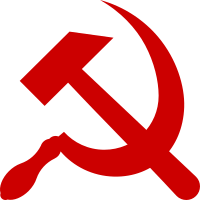
The hammer and sickle (☭) or sickle and hammer (Russian: Серп и молот) is a Communist symbolthat was conceived during the Russian Revolution. At the time of creation, the hammer stood for industrial labourers and the sickle for the peasantry; combined they stood for the worker-peasant alliance for socialism and against reactionary movements and foreign intervention.
After the Russian Civil War, the hammer and sickle became more widely used as symbolizing peaceful labour within the Soviet Union and international proletarian unity. It was taken up by many Communist movements around the world, some with local variations. Today, even after the dissolution of the Soviet Union, the hammer and sickle remains commonplace in Russia and other former union republics, but its display is prohibited in some other former socialist countries.
4 Swastika
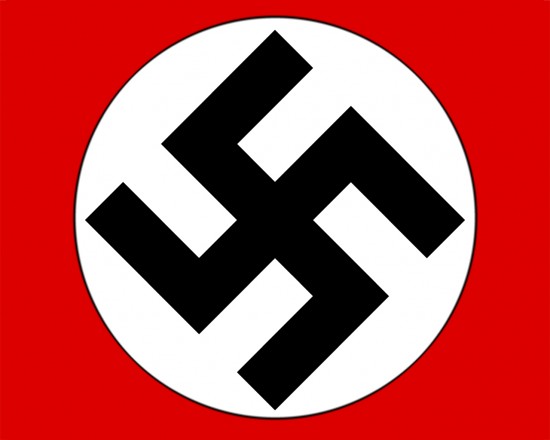
Before Hitler adopted the Swastika as a symbol of the National Socialist Party, it had experienced a renaissance in Western Europe for several decades as a symbol of luck and good fortune before Hitler borrowed those sentiments to rally support behind the Nazi party.
In truth, the swastika has been found on objects from as early as 4,000-10,000 B.C. The Indus Valley Civilization religions of Hinduism, Buddhism and Jainism still use the symbol to signify either divine auspiciousness or the sun’s rays. In Buddhism, some believe a swastika was stamped on Buddha’s chest when he was buried, known as the Heart’s Seal.
5 Cross
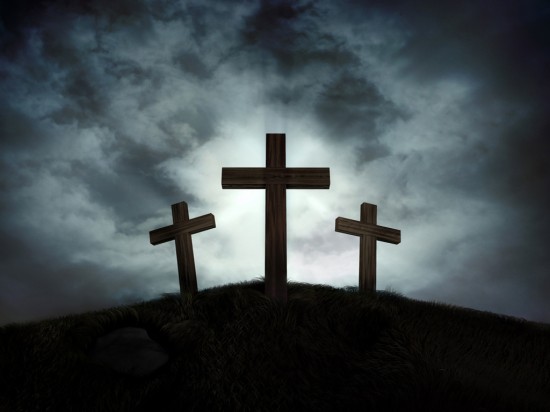
Before Christianity adopted the cross as its emblem, it was a pagan symbol for the Sun-God and signified the perfect union of male and female energy. (The original crosses had equal length axes). The Pope still wears the original cross, which kind of makes sense when you consider Christians hold Jesus as the Son of God.
The Roman Emperor, Constantine, was a practicing sun-worshipping pagan, so perhaps the Roman Empire’s adoption of Christianity as its main religion and consequently, the cross its main symbol, was of no coincidence.
The Origin:
It's a blood-soaked bandage.
The barber pole first emerged during the Middle Ages as a sign used by barber-surgeons. Yes, you read that correctly -- back then, doctors considered themselves much too classy to participate in anything so vulgar as slicing people open, so the task fell upon barbers, whose job descriptions were considerably broader than they are today. Back then, barbers did all the usual barber stuff like cutting hair and trimming beards, but if you had the cash, they were also happy to pull teeth and remove gallstones.
The most common surgical procedure of the time was bloodletting -- literally, the belief that you could just bleed a disease out of you. To do this, the patient would grasp a bandaged pole, and the barber would cut into the patient's wrists, letting the blood run down the bandage, along with all the bad spirits and gypsy curses that they figured were the reasons for disease back then. And that's what the pole represented.
It's a little harder to explain, however, why barbers would openly advertise that one part of their job that involved stealing other people's blood in the first place. It says something about the era that they didn't feel the need to dress it up, the way modern toilet paper ads won't show people pooping. No pics of smiling customers or happy slogans, just "Come on in, you're gonna bleed all over the damned place."
2 The Peace Sign

The peace sign remains one of the most powerful and inspiring symbols on the planet, despite its long association with hippies. Maybe it's the simple geometric shapes that speak to some primal part of our brains, but looking at it, you do feel this sort of grandiosity, hope and conviction from it.
Unfortunately, all of that's basically the polar opposite of what the symbol's creator had in mind.
"It was actually supposed to be a picture of a cherry pie. I just suck at drawing."
The Origin:
Originally, it was an image of a dude slumped over in despair.
Gerald Holtom, a British graphic designer, came up with the peace sign design in 1958 to be used at a protest against nuclear weapons. It's actually a kind of double entendre: People have adopted one interpretation of the symbol, two superimposed semaphore letters -- N and D -- which were meant to stand for "nuclear disarmament."

Either that or "nonstop dancing."
But what we've forgotten was the primary image that Holtom was trying to portray: In his own words, his logo was meant to be a "human being in despair." The inspirational peace sign is in actuality a representation of a man who has lost hope in a world gone mad, stretching his arms out and downward in desperation and defeat.
Holtom immediately regretted his depressing-as-hell image after it went mainstream and tried to change it by flipping it upside-down so that the arms were stretched up into the air. He could even have kept his semaphore imagery, because the V-shape in semaphore is a U, for "unilateral."
But the alternative version failed to catch on. Instead, a depressed and defeated stick man became the inspirational symbol for every progressive movement of the late 20th century, from Vietnam to civil rights. We can suppose it wouldn't have caught on so well if he had gone with his alternative design of a stick man quietly slashing his own wrists.
3 Hammer and sickle

The hammer and sickle (☭) or sickle and hammer (Russian: Серп и молот) is a Communist symbolthat was conceived during the Russian Revolution. At the time of creation, the hammer stood for industrial labourers and the sickle for the peasantry; combined they stood for the worker-peasant alliance for socialism and against reactionary movements and foreign intervention.
After the Russian Civil War, the hammer and sickle became more widely used as symbolizing peaceful labour within the Soviet Union and international proletarian unity. It was taken up by many Communist movements around the world, some with local variations. Today, even after the dissolution of the Soviet Union, the hammer and sickle remains commonplace in Russia and other former union republics, but its display is prohibited in some other former socialist countries.
4 Swastika

Before Hitler adopted the Swastika as a symbol of the National Socialist Party, it had experienced a renaissance in Western Europe for several decades as a symbol of luck and good fortune before Hitler borrowed those sentiments to rally support behind the Nazi party.
In truth, the swastika has been found on objects from as early as 4,000-10,000 B.C. The Indus Valley Civilization religions of Hinduism, Buddhism and Jainism still use the symbol to signify either divine auspiciousness or the sun’s rays. In Buddhism, some believe a swastika was stamped on Buddha’s chest when he was buried, known as the Heart’s Seal.
5 Cross

Before Christianity adopted the cross as its emblem, it was a pagan symbol for the Sun-God and signified the perfect union of male and female energy. (The original crosses had equal length axes). The Pope still wears the original cross, which kind of makes sense when you consider Christians hold Jesus as the Son of God.
The Roman Emperor, Constantine, was a practicing sun-worshipping pagan, so perhaps the Roman Empire’s adoption of Christianity as its main religion and consequently, the cross its main symbol, was of no coincidence.
6 Star of David
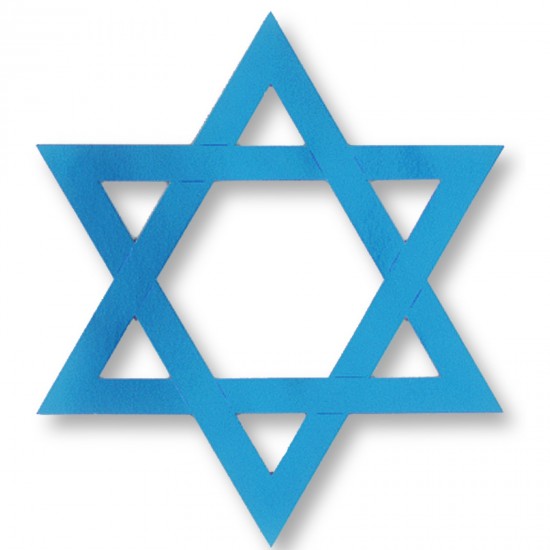
While the hexagram is currently Israel’s primary symbol, representing the Shield of David, its origins are far older than 1018 A.D., when the first recorded Judaic use surfaced.
South Indian temples dating back thousands of years have hexagrams (some with swastikas beside them) adorning their exteriors. The Hindus hold the hexagram as a mandala and use it to represent the heart chakra. In the ancient Tibetan Book of the Dead, there are images of a swastika inside the hexagram representing the creative force in the universe.
If Hitler was trying to represent Jews as evil, he surely used the wrong symbol. The hexagram is used in nearly a dozen religions around the world, always signifying a positive or strong principle.

While the hexagram is currently Israel’s primary symbol, representing the Shield of David, its origins are far older than 1018 A.D., when the first recorded Judaic use surfaced.
South Indian temples dating back thousands of years have hexagrams (some with swastikas beside them) adorning their exteriors. The Hindus hold the hexagram as a mandala and use it to represent the heart chakra. In the ancient Tibetan Book of the Dead, there are images of a swastika inside the hexagram representing the creative force in the universe.
If Hitler was trying to represent Jews as evil, he surely used the wrong symbol. The hexagram is used in nearly a dozen religions around the world, always signifying a positive or strong principle.
7 Muslim Crescent Moon
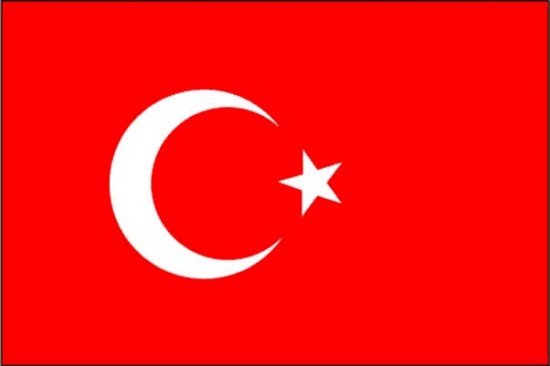
Although the use of “Holy Symbols” is against Muslim law, the crescent moon adorns the flag of a few Muslim nations and has been adopted to unofficially symbolize Islamic faith.
The crescent moon is one of humanity’s oldest symbols, representing the feminine aspect of life, worshipped famously in the form of ancient Greek goddess, Artemis, who always had a crescent moon circling her head. In Roman times the symbol was adopted by Diana, a goddess of hunt and moon, who was said to protect virgins.

Although the use of “Holy Symbols” is against Muslim law, the crescent moon adorns the flag of a few Muslim nations and has been adopted to unofficially symbolize Islamic faith.
The crescent moon is one of humanity’s oldest symbols, representing the feminine aspect of life, worshipped famously in the form of ancient Greek goddess, Artemis, who always had a crescent moon circling her head. In Roman times the symbol was adopted by Diana, a goddess of hunt and moon, who was said to protect virgins.
8 The Eye of Providence
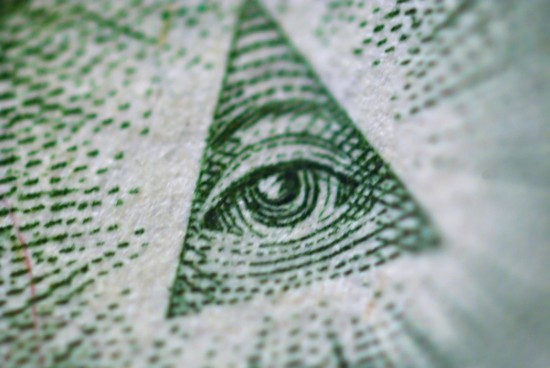
The famous symbol on the U.S. dollar bill is said to represent the eye of god watching over the land. Masons use the symbol to remind them that their actions and thoughts are always observed by the great architect of the universe.
The Egyptians gave Horus a single eye surrounded by sun beams, while in Buddhism the “Eye of God” means to open the top of the dome, the Sun Gate, which is God consciousness.

The famous symbol on the U.S. dollar bill is said to represent the eye of god watching over the land. Masons use the symbol to remind them that their actions and thoughts are always observed by the great architect of the universe.
The Egyptians gave Horus a single eye surrounded by sun beams, while in Buddhism the “Eye of God” means to open the top of the dome, the Sun Gate, which is God consciousness.
9 The Jesus Fish
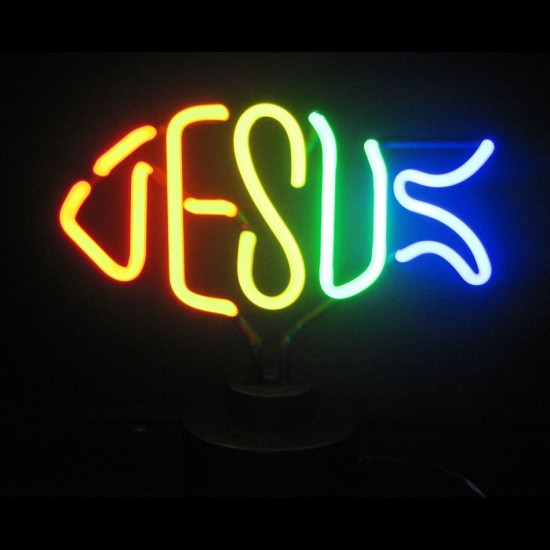
Used by Christians today to represent Jesus, the sign of the fish (actually two intersecting arcs), the symbol was originally used by Christians as a secret symbol of identification to avoid persecution.
The symbol dates back as far as ancient Egypt, Greece and Mesopotamia. Fish are creatures of the water and thus were always associated with cyclical birth and rebirth. The Mesopotamian god, Oannes, also known as “the Reveler”, is said to be a precursor to Christ.

Used by Christians today to represent Jesus, the sign of the fish (actually two intersecting arcs), the symbol was originally used by Christians as a secret symbol of identification to avoid persecution.
The symbol dates back as far as ancient Egypt, Greece and Mesopotamia. Fish are creatures of the water and thus were always associated with cyclical birth and rebirth. The Mesopotamian god, Oannes, also known as “the Reveler”, is said to be a precursor to Christ.
10 Arabic Hamsa
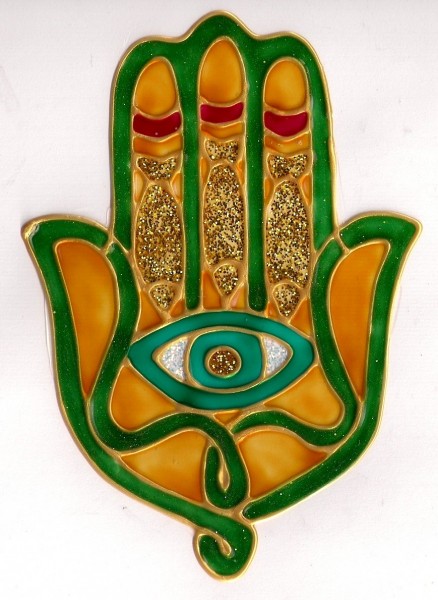
The hand-shaped amulet with an eye at the center of its palm is used mostly in Arabic cultures as a protection against the evil eye. It’s also known as the Hand of Fatima, for Mohammad’s daughter, and as the Hand of Miriam in Judaism, for the sister of Moses.
The Open Hand had been used in ancient cultures: in Buddhism the open hand signifies that all points of the teaching are visible, while in Hinduism, the downward pointed open hand signifies “giving.”

The hand-shaped amulet with an eye at the center of its palm is used mostly in Arabic cultures as a protection against the evil eye. It’s also known as the Hand of Fatima, for Mohammad’s daughter, and as the Hand of Miriam in Judaism, for the sister of Moses.
The Open Hand had been used in ancient cultures: in Buddhism the open hand signifies that all points of the teaching are visible, while in Hinduism, the downward pointed open hand signifies “giving.”


